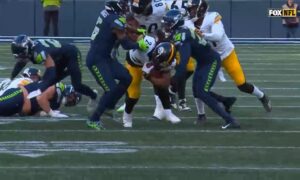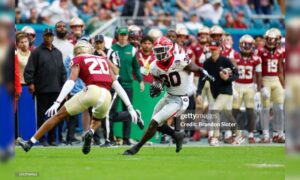For much of the past decade, Pittsburgh’s lagged far short of league average in terms of spending in the secondary. Nonetheless, a linebacker room filled with coverage capable players the likes of Lawrence Timmons, Ryan Shazier, and to a lesser degree, Vince Williams, allowed the team to survive on a heavy diet of zone coverage.
In the years following the tragic loss of a perennial All-Pro talent in Ryan Shazier, Pittsburgh has often struggled to find blitzing and coverage ability, along with takeaway production from the off-ball linebacker position. Devin Bush, a proposed answer to the problem, never matched his promising rookie year production, finishing his Steelers career with 13 tackles for losses, ten quarterback hits, four sacks, two forced fumbles, two interceptions, and 13 passes defended. He finished his final season in Pittsburgh with two tackles for losses, two quarterback hits, and two passes defended, with no takeaway production to speak of.
Advanced stats paint an even grimmer picture of the situation, with Bush posting a 107.1 passer rating and a 73.7% completion rate when targeted this past season, both worst of his four year career. Ultimately, he serves as the latest example of an often misrepresented truth, that being that all athletic linebackers are poised to excel in coverage. Factor in just three pressures on 31 blitz attempts, and it becomes crystal clear that he was not much of a factor in that department either.
Looking into the next of Pittsburgh’s options at the position from last season, that being free-agent addition Myles Jack, and production was not much better. In his lone season in Western PA, Jack finished the season with just three tackles for losses, a quarterback hit, and three passes defended in 15 games of action, 13 of which he started. His advanced numbers were astoundingly slightly worse than that of his counterpart, with a 107.4 passer rating and a 76.4% completion rate allowed when targeted as the primary defender. As for those blitz numbers, just one recorded pressure on 21 attempts, along with no takeaway production.
Jumping over to Robert Spillane, who was a known favorite of Mike Tomlin’s, and inexplicably, the team’s designated Dime package linebacker, the numbers ultimately net out the worst of the three options. Despite serving as a physical downhill presence in the run game, Spillane’s weaknesses were often exposed, both when asked to work laterally in defending perimeter run action and when asked to handle isolated man coverage matchups in the pass game.
On the season, Spillane totaled four tackles for losses, a sack, and four passes defended in sixteen games of action. In terms of his advanced numbers, he was similarly unproductive, with a 109.2 passer rating and 83.7% passer rating allowed when targeted as the primary defender. Likewise, on 42 blitz attempts, the most of the group, he totaled just three pressures.
With all three options combining to produce just nine tackles for losses, nine passes defended and a single sack, it is no wonder that the Pittsburgh front office ultimately decided to move on from all three options, replacing them with a pair of veteran free-agents. The lone piece remaining from the 2022 group is Mark Robinson, who flashed physicality and downhill ability as a rookie, but is still raw and likely can not be relied upon in coverage at this stage of his career.
The bigger name of the two incoming free agents is Cole Holcomb, formerly of the Washington Commanders, who played just seven games this past season after a productive 2021 campaign in the nation’s capital. In evaluating the larger sample size, that being 2021 when Holcomb played in 16 games, Holcomb put together solid production with 142 tackles, two tackles for losses, one sack, two forced fumbles, two interceptions, seven passes defended, and a pick six.
While it is a remarkably low bar to clear, Holcomb’s advanced numbers grade out better than last year’s trio, with a 95.7 passer rating and a 74.1% completion rate allowed when targeted as the primary defender. As a blitzer, however, he did not fare much better, with just six pressures on 52 attempts. While the advanced numbers present concern, if Holcomb can add anything in the neighborhood of the four takeaway opportunities that he created in 2021, that would be four times more than the entire unit from this past season.
Ultimately, it is reasonable to expect Holcomb to offer the Steelers better perimeter run support from the second level and tangible turnover production from the off ball linebacker position. All that being said, his addition to the room likely does not come in the form of a plus defender in pass coverage, particularly in a defensive scheme that relies on single-high man coverage at a top third rate league wide.
Moving onto Elandon Roberts, the second of two offseason additions at the position, Pittsburgh aimed to address its lack of production in terms of penetration and production behind the line of scrimmage. This past season in Miami, Roberts totaled 107 tackles, 4.5 sacks, and 10 tackles for losses, notably totaling more sacks and tackles for losses than Pittsburgh’s entire linebacker rotation from last season.
While he is certainly exposable in coverage, with a 121.9 passer rating and 80.0% completion rate allowed as the primary coverage defender this past season, his seven recorded pressures on just 33 blitz attempts present intrigue for what he can offer in that department. Overall, it is reasonable to assume that Roberts will be able to provide a downhill presence, both in the run and pass game, that the team has lacked since the retirement of Vince Williams.
Overall, with the additions of Holcomb and Roberts, Pittsburgh placed an emphasis on adding splash play potential in terms of takeaway production and blitzing ability on passing downs. Likewise, in the run game, Pittsburgh has added both a productive perimeter run defender in Holcomb and a solid downhill penetrator in Roberts. While both players can potentially be exploited when left in isolated man coverage matchups, Roberts in particular offers some nice juice as a pass rusher while playing off-ball.
Last season, Pittsburgh’s defense tied atop the league lead in interceptions with 20, 18 of which came from the secondary, with the other two of which came from TJ Watt. Nonetheless, Pittsburgh finished middle of the pack in terms of total takeaways, with just 23 in total. A healthy season from the pass rush unit, along with what should be improved off-ball linebacker play in terms of splash play production, could vault the unit back towards the top of the league in takeaway production, in line with the unit’s production in 2019 and 2020.
While it is unreasonable to expect All-Pro, or even Pro-Bowl level production from the off-ball linebacker position this season, even average to slightly above average production at the position would serve as a massive upgrade from where the unit has been for the past half decade.
Ultimately, the health of Cole Holcomb, who has been far from reliable in that department, will be a large determining factor in terms of the success of the unit. While Mark Robinson, although far less refined, provides a similar skillset to that of Elandon Roberts, Holcomb’s skillset is much more unique to the roster. He will likely serve as the every down linebacker, staying on the field in Dime packages, which Pittsburgh deploys at a healthy rate on third down.
I fully expect Pittsburgh to have a top flight defense this upcoming season, particularly as the pass rush rounds back into form. That being said, splash play production at the off-ball linebacker position has held the unit back in the past, and will ultimately determine the ceiling of how the collective unit will perform.
Hence, we are left asking whether the tandem of Holcomb and Roberts represent yet another failed, short term band-aid solution at the position, or whether Pittsburgh has finally addressed its long term shortcomings at the position? While these questions ultimately remain unanswered until Pittsburgh takes the field this fall, there are certainly reasons for optimism.








